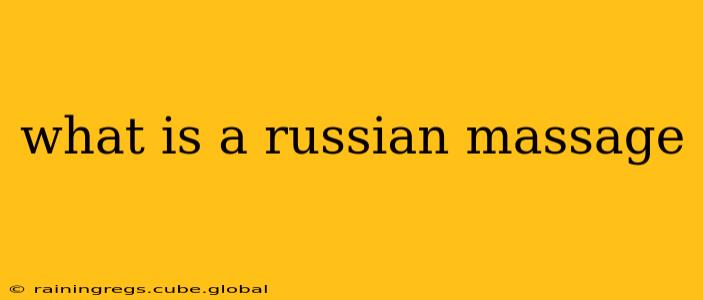The term "Russian massage" can be misleading, as it doesn't refer to a single, standardized massage technique officially recognized in Russia. Instead, it's a broad term often used to describe a style emphasizing deep tissue work, vigorous strokes, and a focus on improving athletic performance and recovery. The techniques used under the "Russian massage" umbrella are often a blend of several traditional massage modalities adapted and modified over time.
It's crucial to distinguish this from traditional Russian folk healing practices, which encompass a much wider range of therapies beyond massage.
What techniques are typically included in a "Russian massage"?
A "Russian massage" typically incorporates elements from several massage techniques, resulting in a highly individualized experience depending on the therapist and the client's needs. Common elements include:
- Deep Tissue Massage: This focuses on releasing tension in the deeper layers of muscle and connective tissue. Expect firm pressure and slow, deliberate strokes.
- Sports Massage: Designed to improve athletic performance, prevent injuries, and aid in recovery. This often includes techniques to increase blood flow, reduce muscle soreness, and improve flexibility.
- Classic Swedish Massage: While less emphasized than deep tissue work, some therapists incorporate elements of Swedish massage, such as effleurage (long, gliding strokes) and petrissage (kneading).
- Trigger Point Therapy: This involves applying pressure to specific points in the muscles to release tension and alleviate pain.
What are the benefits of a Russian massage?
The potential benefits often cited for a "Russian massage" largely stem from the deep tissue and sports massage elements:
- Improved muscle recovery: Helps reduce muscle soreness and stiffness after intense physical activity.
- Increased flexibility and range of motion: Helps loosen tight muscles and improve joint mobility.
- Reduced pain and tension: Relieves muscle pain and tension headaches.
- Improved circulation: Stimulates blood flow, promoting healing and reducing inflammation.
- Stress reduction: The deep pressure and rhythmic strokes can promote relaxation and reduce stress levels.
Is a Russian massage painful?
The intensity of a "Russian massage" varies greatly depending on the therapist's technique and the client's preferences. While it's typically described as a deep tissue massage, some therapists may adjust the pressure according to individual needs. It's important to communicate your comfort level with the therapist throughout the session. Some discomfort is expected with deep tissue work, but it shouldn't be unbearable pain.
What's the difference between a Russian massage and a Swedish massage?
The primary difference lies in the intensity and depth of the work. Swedish massage focuses on long, flowing strokes and gentle manipulation to promote relaxation and improve circulation. "Russian massage," on the other hand, tends to be more vigorous and involves deeper pressure to target muscle tension and improve athletic performance.
How long is a typical Russian massage session?
The duration of a "Russian massage" varies, typically ranging from 60 to 90 minutes. The specific time depends on the therapist and the client's needs.
Where can I find a therapist who offers a Russian massage?
Finding a therapist offering a "Russian massage" might require some research. Search online for massage therapists in your area and check their websites or call to inquire about their specific techniques and experience with deep tissue or sports massage. Remember to check reviews and credentials before booking an appointment.
Disclaimer: This information is for general knowledge and informational purposes only, and does not constitute medical advice. It is essential to consult with a qualified healthcare professional before undergoing any massage therapy, especially if you have pre-existing health conditions. The effectiveness of massage therapy can vary significantly from person to person.
